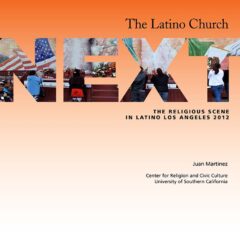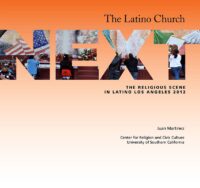Latinos became the largest minority group in the United States during the first decade of the twentyfirst century. The Latino presence is even more pronounced in Los Angeles since they represent 50 percent of the population of the city and 48 percent of the county. Yet this demographic heft is not reflected in political, social, or economic influence. And even in the religious sphere, where Latinos have a higher Christian commitment than the population at large, their role is limited, at best. According to a 2007 Pew study of Latino religious tendencies,* 68 percent of Latinos are Catholics, 20 percent are Protestants, three percent are other types of Christians (Jehovah’s Witnesses, Mormons, Orthodox), one percent are adherents of other religions and eight percent define themselves as secular (though some of those in this category might define themselves as spiritual).
This means that in L.A. County there are currently about 3.3 million Latino Catholics, over 970,000 Latino Protestants, about 146,000 Latinos who are part of other Christian groups, and about 390,000 that are secular and 48,000 that are part of other religions. About 75 percent of the Protestants are part of evangelical or Pentecostal churches, and 25 percent belong to mainline denominations. Among Latinos nationally, 68 percent of Catholics, 55 percent of evangelicals/Pentecostals and 35 percent of mainline Protestants were born in Latin America. The Pew study charts similar trends in Spanish language usage in worship, though the tendency, at least for Catholics, is to continue worshiping in Spanish, even among English-speaking populations. It is also worth noting that according to the Pew study 54 percent of Latina Catholics identify themselves as charismatic and 28 percent identify themselves as being born again.
So, though the vast majority of Latinos are Catholics, many of them also identify with religious practices that are more commonly identified with evangelicals and Pentecostals. The percentage of Latinos who identify themselves as Catholic is decreasing, and a growing number of Catholics identify with “Protestant” religious practices. Protestants and other non-Catholic groups account for an increasing percentage of religious (or nonreligious) practice in the community. Latinas also reflect the growing number of Christians who identify with independent churches or who downplay or reject traditional denominational labels. But these differences are not uniform among all Latinos. There are clear differences depending on national background and on how Latinas interact with the dominant culture.
Generational shifts, migration flows, education and many of the other diversities in the Latino community are also important factors. The religious background of Latinos in Los Angeles roughly parallels the national profile of the Latino population at large with one major exception: the percentage of Protestants from Mexican and Central American backgrounds. In L.A. County 75 percent of the Latina population is of Mexican background and 14 percent is of Central American descent. Yet among Latino Protestants the Mexican percentage (16 percent) is lower and the Central American percentage is higher (25 percent) than among the Latino population at large. (These numbers are much more pronounced among people from Puerto Rico who are 36 percent Protestant.) Most likely, this is because a larger percentage of the population of Central America is Protestant than in Mexico.
This means that Mexican immigrants are much more likely to be Roman Catholic when they come to Los Angeles and that they are most likely to remain Catholic once they are here. Given that Mexicans continue to identify with Catholicism more strongly than any other nationality in Latin America, it seems likely that people of Mexican descent will continue to be overrepresented among Latino Catholics and underrepresented among Protestants, as a total of the Latino population in Los Angeles. The growth of Latino Catholicism is slowly making a difference among Catholics in Los Angeles.
For the first time in the U.S. history of the Archdiocese of Los Angeles, a Mexican, José Gómez, has been named archbishop. Since Latinos comprise over 70 percent of the parishioners in the Archdiocese, why did it not happen before? Will this new archbishop be able to recruit more Latinos for the priesthood? Will he encourage the accredited Catholic schools in the diocese to develop Spanish language theological programs to train Latina lay leaders? Latinos do not have the same type of representation in most Protestant denominations, though even there one sees a change. For example, Latinos now constitute about 25 percent of the Assemblies of God (AG) nationally, and close to 50 percent in Southern California.
In 2011, the “Latino” district of Southern California (Southern Pacific) planted the most churches of all AG districts in the United States. The current superintendent of the traditionally “Anglo” Los Angeles district is a Latino formed in a Latino church. Are the Assemblies of God harbingers of the future? Latinos are a growing percentage of believers in most Pentecostal and evangelical churches. In contrast, the churches in Los Angeles that are dying (mostly those associated with mainline denominations) are those where Latinas have a very limited role. But these numbers do not take into account the growing number of Latinos who attend non-Latino Protestant churches, because many of them seem invisible in those churches. Sometimes churches are very happy to have them there as long as they remain under the radar. Some of these churches act as if Los Angeles were never a Mexican city and that half of the population is not Latino.
Another group that is often not taken into account is the growing number of Latin American or Latino-based Pentecostal groups in Los Angeles. Some, like the Apostolic Assembly of the Faith in Christ Jesus, were born in the Los Angeles area almost a century ago. But many are much more recent, including some of the largest Latino churches in the Los Angeles area, like Elim, Ministerios Restauración and Llamada Final. Of course, Latinos are also diversifying their religious tendencies. Mormon and Jehovah’s Witness communities have been relatively popular among Latinos for many years, as can be seen by the number of “Kingdom Halls” that have prominent signs in Spanish on the outside. One can also find a small but growing number of Latino Muslims in Los Angeles. If one looks carefully, one can even find Spanish language Islamic literature in the city.
*Changing Faiths Latinos and the Transformation of American Religion. The Pew Forum on Religion and Public Life and the Pew Hispanic Center, 2007.
To summarize the demographic profile of Latino religion in Los Angeles:
• The number of Latino Catholics in Los Angeles is growing because of continuing migration. Latinos will be a growing percentage of the Catholic population, though Catholicism will continue to shrink as a percentage of the Latino population.
• Latino Pentecostalism is growing and influencing Latino Protestantism and even Latino Catholicism.
• Modern Pentecostalism was born in Los Angeles, but new movements from Latin America (and other places) are bringing new forms of Pentecostalism back to Los Angeles.
• Groups like Mormons and Jehovah’s Witnesses will continue to grow among Latinos.
• Being in Los Angeles creates more religious diversification. Second and third generation Latinos are more likely to be Protestants, Muslims or secularized than the immigrant population.
• Central Americans and Puerto Ricans will tend to be “overrepresented” among Protestants. People of Mexican descent will
tend to be more Catholic.
Latinos as % of population in L.A. County
| 1990 | 2000 | 2010 | |
|---|---|---|---|
| Total Population (count) | 8,863,164 | 9,519,338 | 9,818,605 |
| White | 57% | 49% | 50% |
| African American | 11% | 10 | 9 |
| Asian | 11% | 12 | 14 |
| Other Race | 21% | 24 | 27 |
| Hispanic Origin of any race | 38% | 45 | 48 |
*Source: U.S. Census Bureau (www.census.gov) accessed 12/6/2010; updated 11/19/2011
Latino Religious Affiliations
Catholic 68%
Protestant 20%
Other Christian 3%
Other Religion 1%
Secular 8%
Charismatic/Pentecostal
Percent of Latino Catholics who identify as charismatic or Pentecostal 54%
Percent of Latino Protestants who identify as charismatic or Pentecostal 57%
| Native Born | Foreign Born | |
|---|---|---|
| All Latinos | 38% | 62% |
| Catholic | 32% | 68% |
| Evangelical | 46% | 55% |
| Mainline Protestant | 65% | 35% |
| Other Christian | 43% | 57% |
| Secular | 49% | 51% |
*Source: “Changing Faiths: Latinos and the Transformation of American Religion.” The Pew Forum on Religion and Public Life and the Pew Hispanic Center, 2007
Juan Martinez is a former fellow with the USC Center for Religion and Civic Culture.


